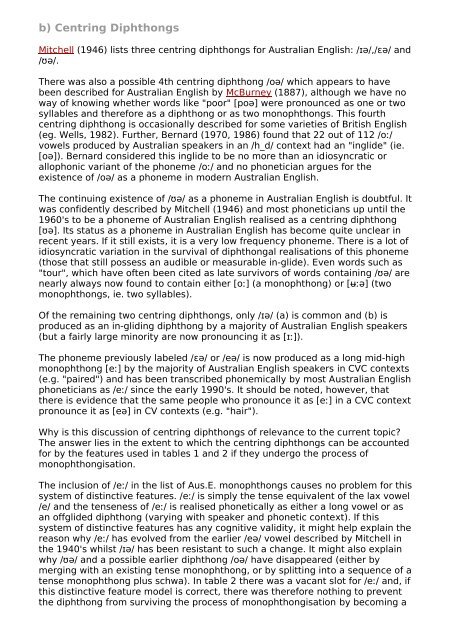Distinctive Features - Speech Resource Pages - Macquarie University
Distinctive Features - Speech Resource Pages - Macquarie University
Distinctive Features - Speech Resource Pages - Macquarie University
Create successful ePaper yourself
Turn your PDF publications into a flip-book with our unique Google optimized e-Paper software.
) Centring Diphthongs<br />
Mitchell (1946) lists three centring diphthongs for Australian English: /ɪə/,/ɛə/ and<br />
/ʊə/.<br />
There was also a possible 4th centring diphthong /oə/ which appears to have<br />
been described for Australian English by McBurney (1887), although we have no<br />
way of knowing whether words like "poor" [poə] were pronounced as one or two<br />
syllables and therefore as a diphthong or as two monophthongs. This fourth<br />
centring diphthong is occasionally described for some varieties of British English<br />
(eg. Wells, 1982). Further, Bernard (1970, 1986) found that 22 out of 112 /oː/<br />
vowels produced by Australian speakers in an /h_d/ context had an "inglide" (ie.<br />
[oə]). Bernard considered this inglide to be no more than an idiosyncratic or<br />
allophonic variant of the phoneme /oː/ and no phonetician argues for the<br />
existence of /oə/ as a phoneme in modern Australian English.<br />
The continuing existence of /ʊə/ as a phoneme in Australian English is doubtful. It<br />
was confidently described by Mitchell (1946) and most phoneticians up until the<br />
1960's to be a phoneme of Australian English realised as a centring diphthong<br />
[ʊə]. Its status as a phoneme in Australian English has become quite unclear in<br />
recent years. If it still exists, it is a very low frequency phoneme. There is a lot of<br />
idiosyncratic variation in the survival of diphthongal realisations of this phoneme<br />
(those that still possess an audible or measurable in-glide). Even words such as<br />
"tour", which have often been cited as late survivors of words containing /ʊə/ are<br />
nearly always now found to contain either [oː] (a monophthong) or [ʉːə] (two<br />
monophthongs, ie. two syllables).<br />
Of the remaining two centring diphthongs, only /ɪə/ (a) is common and (b) is<br />
produced as an in-gliding diphthong by a majority of Australian English speakers<br />
(but a fairly large minority are now pronouncing it as [ɪː]).<br />
The phoneme previously labeled /ɛə/ or /eə/ is now produced as a long mid-high<br />
monophthong [eː] by the majority of Australian English speakers in CVC contexts<br />
(e.g. "paired") and has been transcribed phonemically by most Australian English<br />
phoneticians as /eː/ since the early 1990's. It should be noted, however, that<br />
there is evidence that the same people who pronounce it as [eː] in a CVC context<br />
pronounce it as [eə] in CV contexts (e.g. "hair").<br />
Why is this discussion of centring diphthongs of relevance to the current topic?<br />
The answer lies in the extent to which the centring diphthongs can be accounted<br />
for by the features used in tables 1 and 2 if they undergo the process of<br />
monophthongisation.<br />
The inclusion of /eː/ in the list of Aus.E. monophthongs causes no problem for this<br />
system of distinctive features. /eː/ is simply the tense equivalent of the lax vowel<br />
/e/ and the tenseness of /eː/ is realised phonetically as either a long vowel or as<br />
an offglided diphthong (varying with speaker and phonetic context). If this<br />
system of distinctive features has any cognitive validity, it might help explain the<br />
reason why /eː/ has evolved from the earlier /eə/ vowel described by Mitchell in<br />
the 1940's whilst /ɪə/ has been resistant to such a change. It might also explain<br />
why /ʊə/ and a possible earlier diphthong /oə/ have disappeared (either by<br />
merging with an existing tense monophthong, or by splitting into a sequence of a<br />
tense monophthong plus schwa). In table 2 there was a vacant slot for /eː/ and, if<br />
this distinctive feature model is correct, there was therefore nothing to prevent<br />
the diphthong from surviving the process of monophthongisation by becoming a
















